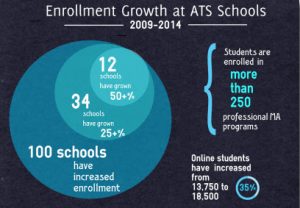 Nearly every regular reader of this blog is well aware that American Christianity has been in decline for many years. Given this reality one would expect that seminary enrollment would also be declining since this schooling is often required of those seeking ordination (and in traditions where such advanced degrees are not required they have long been an attractive and helpful professional credential). According to a new report from the Association of Theological Schools, more than 1 in 3 (37%) of its member schools have experienced enrollment growth during the last five years.
Nearly every regular reader of this blog is well aware that American Christianity has been in decline for many years. Given this reality one would expect that seminary enrollment would also be declining since this schooling is often required of those seeking ordination (and in traditions where such advanced degrees are not required they have long been an attractive and helpful professional credential). According to a new report from the Association of Theological Schools, more than 1 in 3 (37%) of its member schools have experienced enrollment growth during the last five years.
Reasons for Growth
Daniel O. Aleshire, executive director of ATS suggests that there is no one reason why certain seminaries are growing while others are not. He claims “The reasons that some schools have enjoyed extraordinary enrollment growth during the past five years are idiosyncratic. Each growing school has its own success story to tell.”
Tom Tanner and Eliza Smith Brown note that size is not a factor in growth (unlike in churches where larger churches are more likely to be growing). More specifically, “The list of 100 growing seminaries divides between 43 percent above the current ATS median size of 150 students and 57 percent below.”
Tanner and Brown find that two changes are correlated with increased likelihood of growth:
- new degree programs – two-year professional MAs have reached a record number of students, and
- new delivery systems – online students increased by 35%.
So What?
I entered ministry in a generation when the M.Div. was expected by Mainline Protestant traditions and was becoming increasingly normative in Evangelical Protestant traditions. Over the last few decades, however, many questions have arisen about the long term sustainability of such an educational foundation for ministry. Many of these arguments consider (1) the rising cost of residential seminary education (both the actual cost of the programs as well as the relocation costs for individuals and their families) and the increased debt load associated with such costs, (2) the significant percentage of students who enter seminary later in life as preparation for a second or third career (shorter time horizon for return on educational investment and increased likelihood a relocation involves a family rather than an individual), (3) the changing nature of ministry and increased variety in ministry vocations.
The Mainline Protestant traditions with which I have the greatest experiential familiarity have designed alternative pathways to ministry that allow people to enter ministry positions with different credentials than the M.Div. The ATS has also shifted its requirement for the percentage of a graduate program must be completed in residence (compared to what may be completed online). The seminary students who are seeking MAs in unprecedented numbers also suggest that current students believe there will be significant opportunities for those without a M.Div.
In short, a new era is beginning for the church and a new educational foundation provided by seminaries with experiential learning in field/parish/parachurch ministry settings is needed. Different degrees and new courses within existing degrees are essential ways seminaries can educate people to help prepare for a future that will clearly be marked by significant change. A shift to allowing most or all of programs to be completed online is consistent with trends in higher education more generally and with making seminary education available to a wider audience (and potentially at a decreased cost, especially when relocation is removed for the expense formula).
- What changes do you feel seminaries should be considering in order to (a) grow? (b) better prepare the next generation for ministry?
- What (if any) lessons might churches that seek to grow learn from the 37% of seminaries that are growing?